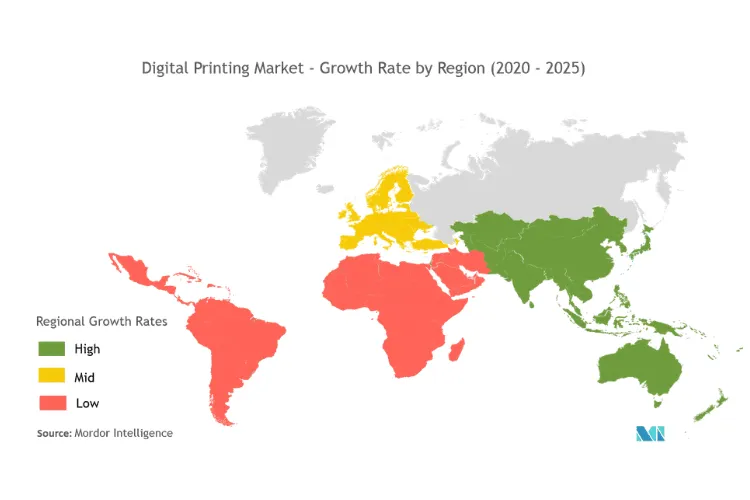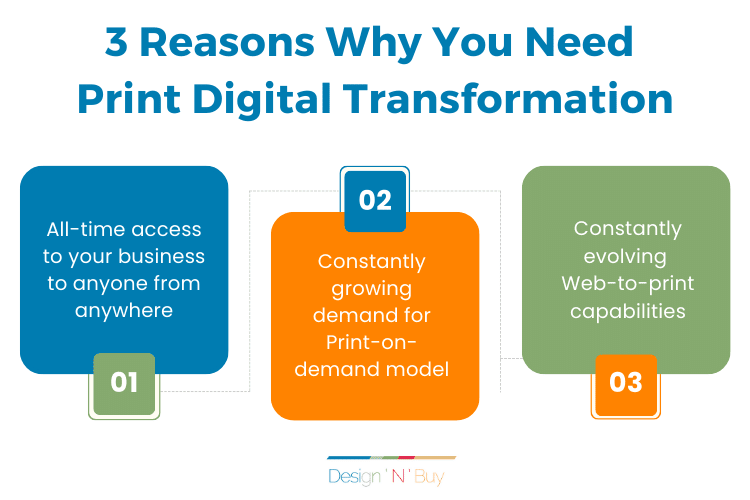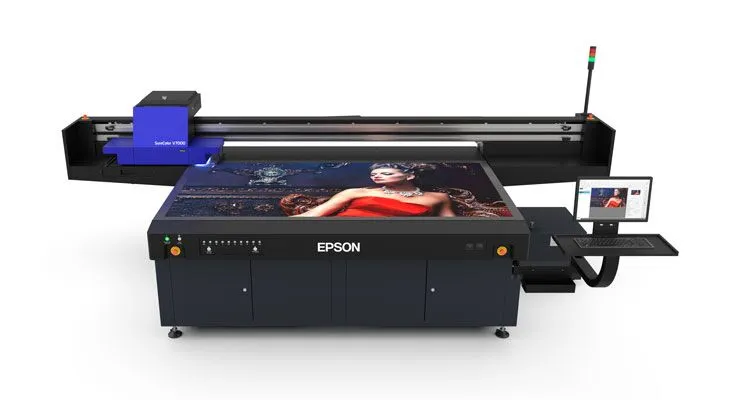Digital transformation typically begins with a focus on the production process. This transformation must, however, extend beyond production and be incorporated into all aspects of a company’s printing operations. This includes integrating administrative processes such as product development, implementing web-to-print technology, optimizing supply chain and logistics management, enhancing service delivery, managing corporate relations, ensuring quality control, and optimizing sales and marketing efforts. By leveraging these capabilities, print companies can create a holistic and unified printing experience that can be tailored to the needs of their customers.
Moreover, this unified approach can provide them with a competitive edge and allow them to capitalize on current and emerging markets. The Digital Print market is growing at an exponential rate and despite the challenges that the Printing Industry faces due to the global pandemic.

What is the future trend in the printing industry? Certainly, here are the statistics in a shortened format:
- The Digital Print market is growing at an exponential rate and despite the challenges that the Printing Industry faces due to the global pandemic. The rising demand for digital printing services and various market trends have helped the printing industry break the limitations of geographical boundaries and it is expected to grow at a CAGR of 6.45 from 2021-26!
- Web-to-print adoption results in a 78% reduction in order processing time (averaging 40% faster).
- Digital supply chain management leads to a 22% decrease in inventory carrying costs through improved forecasting.
- The Asia Pacific region accounts for 35% of the digital print market and North America stands second with 30%. With the increasing adaptation of Digital Printing across the globe, printers are breaking their geographical boundaries and creating a global digital print business. Such is the impact of digital printing that the top 5 Online Print Players of Germany alone registered a whooping 1.7 Billion Euro Revenue from format printing and advertising.
- Integrated sales and marketing efforts yield a 27% average increase in lead conversion rates due to personalized communication.
Based on these concise statistics, it is evident that digital transformation can provide a wide array of benefits across multiple operational areas.
There are a lot of factors that make a Digital Print business a success and as a market leader; we recently did a detailed webinar on the same topic. The webinar is a crunch of our market experience gained from serving 800+ clients from 60+ countries. This blog gives you the key takeaways from the same from the webinar and we bring to you, the upcoming trends of Digital Printing for the year 2025.
But before we jump to how to secure your online success as a Digital Printer, we would like to focus on why you need print digitalization and help you make an informed decision.
3 Reasons Why You Need Print Digital Transformation
In the online e-commerce world, the integration of digital transformation within the realm of print is no longer an option—it’s a necessity. Here’s why

1. All-time access to your business to anyone from anywhere
With an online presence, you can provide your printing services to your customers at the tip of their fingers. Create a mobile-optimized print commerce platform with a mobile-friendly Web-to-print solution and get extensive market reach to your target audience. Whether you wish to cater to multiple states, regions, or countries, with the help of a personalized digital platform and an ideal Web-to-print solution, you can reach your audience at minimal preliminary expenses and resources.
2. Constantly growing demand for Print-on-demand model
Whether you have a B2B or a B2C digital storefront, customers seek a short-term design and delivery model for the fast-paced market. With the rising adaption of web-to-print solutions, printers can deliver quick design templates, get ready to print output files, and fulfill short-term printing demands with digital printing solutions.
3. Constantly evolving Web-to-print capabilities
While conventional business methods still prevail, the increasing capabilities of Web-to-print solutions are driving the success of the digital printing industry. From real-time pricing to user-friendly designing experience to complete design freedom, customers prefer online platforms over offline businesses for these capabilities. They are using them to place varied customized product designing and printing orders.
Top 9 Digital Printing Industry Trends 2025
The print industry has undergone a significant digital transformation, embracing new technologies and strategies to adapt to the evolving landscape. In 2025, several trends are shaping the industry, enabling print businesses to thrive in a digital-first world.
1. All-inclusive print platforms with innovative and customer-centric approaches

In the era of personalization, the success mantra of a digital platform is to deliver what your customers want. Whether it is quick deliveries or a high-quality print, whether customers want sustainable and eco-friendly printing or want customized frames, photo books, or labels, and stickers, the key is to create an all-inclusive platform. To hop on to this trend, you do not have to invest in machinery, resources, and equipments. You can rather collaborate with other printers, allow customers to design their own products with a web-to-print online designer, create design templates for a wide product portfolio and outsource the print file to the relevant printer.
2. Mass Customization (Catering to the customer demand for exclusivity)

With the help of technology solutions such as Web-to-print software, print automation, and inkjet digital printing, industries across the globe can adapt to the customization trends and cater customized products to the mass without compromising on their product quality. For the B2C market, customers are looking for customized cars, gifts and apparel, and other such products. For B2B printers, marketers seek customized marketing solutions, from signages to billboards to stickers to banners. Customers are looking for platforms that can empower them to design their own products and gain access to exclusive products. Not only are customers willing to pay more for the same, but they are also willingly promoting these businesses and helping businesses create positive word of mouth.
Complete Guide To Corporate Gifting Business
3. Social Media Print
Whether we discuss t-shirt trends or the general custom product market, B2C printers must cope with social media trends and capitalize on them. Right from creating design templates of viral social media trends to allowing customers to custom-design their products on their smartphones by downloading images from social media, printers that have integrated social media print models are showing exponential growth and are gaining popularity in the open market.
4. Mobile Printing Takes Center Stage
Mobile printing is gaining traction as mobile devices continue to dominate our lives. Print businesses leverage mobile apps and technologies to enable customers to print directly from their smartphones and tablets. This trend enhances convenience and opens up new avenues for engaging customers on the go.
5. Diverse Range of Digital Printing Devices

The emergence of various types and sizes of digital printing devices redefines the industry. Industrial digital printers, production inkjet presses, and electrographic presses offer unmatched speed, quality, and versatility. These devices cater to different printing scales, from small-scale customized projects to large industrial production.
More for you
- Top 8 Print MIS Software in 2025…Read More→
- Top 10 Wholesale Promotional Product Suppliers in the United States…Read More→
- 9 Best Screen Printing Machines of 2025…Read More→
- Top 5 Print Estimating Software…Read More→
- Best Large Format Printers of 2025…Read More→
- Top 10 DTG Printers (Direct-To-Garment) With Prices…Read More→
- Top 10 Best DTF Printers (Direct To Film Printer) For Tshirt And Promotional Merchandise Printing…Read More→
6. Coexistence of Analog Presses
While digital printing is on the rise, analog presses continue to have a place in the industry. Certain applications and markets still favor the qualities that traditional printing methods bring. This coexistence allows print businesses to offer various options to meet diverse customer needs.
7. Workflow Automation and Web-to-Print Storefronts
Automation is becoming a linchpin in the print industry’s digital transformation. Workflow automation streamlines processes, from order intake to production and delivery, improving efficiency and reducing errors. Web-to-print storefronts provide a seamless online experience for customers to customize and place orders, enhancing convenience and customer satisfaction.
8. Impact of Digital Communications on Printed Graphics
The rise of digital communications doesn’t necessarily mean the demise of printed graphics. In fact, digital and printed media are converging to create immersive experiences. Print materials are designed to complement digital content, creating a cohesive brand presence across online and offline channels.
9. Tailoring Equipment to Niche Markets
The choice of equipment is becoming more strategic, tailored to the niche markets a print business serves. Whether it’s commercial printing, packaging, textiles, or signage, the equipment chosen must align with the target audience’s specific demands. This customization ensures optimal output and customer satisfaction.
Why DesignNBuy for the printing industry?
DesignNBuy is the ideal choice for the printing industry due to its tailored web-to-print solutions that encompass the entire printing pre-press process, intuitive design tools, scalability, seamless integration capabilities, and a customer-centric approach, all of which empower businesses with a competitive edge and efficient workflow while enhancing customer experiences.
The Future of the Print Industry
Now you understand What are the digital printing trends for 2025. In summary, the digital print industry trends in 2025 reflect a dynamic landscape where traditional and digital methods coexist harmoniously. Mobile printing, diverse digital printing devices, automation, and the integration of digital communications are shaping the industry’s trajectory. Print businesses that adapt to these trends can leverage them to deliver superior products, streamline operations, and stay relevant in an ever-changing market.
Schedule a meeting with us and take your first step towards success TODAY!
FAQ
Most Frequently Asked Questions and Their Answers
Digital printing trends include personalization, sustainability, and faster production. Businesses are focusing on customized prints, eco-friendly practices, and quicker turnaround times.
The digital printing industry is growing steadily. It’s hard to pinpoint an exact size, but it’s a multi-billion-dollar industry that continues to expand due to its versatility and cost-effective solutions.
Do you have any more questions? Contact our experts
*This Post has been Updated on January 2025.




